32 scary parasitic diseases
Parasites can cause a wide range of diseases in humans, ranging from short-term to lifelong.
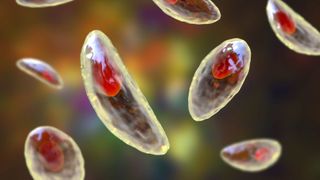
Parasitic diseases, which are passed on to people via parasites found in contaminated food, water, soil or bugs that bite humans, can be relatively uncommon in some parts of the world. In other regions, though, they can be absolutely devastating. Some parasites can cause illnesses that are temporary, but some trigger lifelong medical problems.
Not all parasitic diseases are due to poor sanitation or poverty; you can be exposed to parasites regardless of your socioeconomic situation. Here are 32 parasites that can infect humans, including some well-known culprits and some you may not have heard of.
American trypanosomiasis
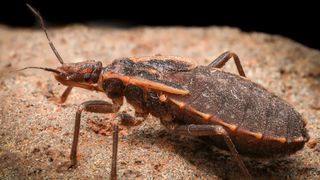
Chagas disease, also known as American trypanosomiasis, is caused by the parasite Trypanosoma cruzi. It's common in rural areas of Latin America, and its range, overall, is confined to North and South America. Insects known as kissing bugs get the parasite from an infected animal or person and then pass the parasites in their feces. Kissing bugs tend to bite their victims on the face, then defecate on the bitten person or animal. If their feces gets into the body — as might happen if you were to scratch the wound — you could get infected. Though the initial symptoms include fever, headache or rash, Chagas disease can be a lifelong illness that results in cardiac and gastrointestinal problems.
Bed bugs
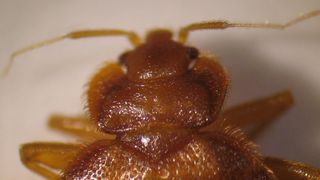
Bed bugs are well-known parasitic insects that can damage furnishings with their staining poop and leave people itchy — but thankfully, these insects can't cause you lasting damage.
Two species of the bugs, called Cimex hemipterus and Cimex lectularius, feed on humans and animals and are found across the globe. They can go months without a meal and still survive, which makes it easier for them to spread. Everyone's at risk of being bitten by bed bugs, especially if you travel. Bed bugs can cause itching, but they cannot spread disease like other parasites and don't pose a serious medical threat. You may notice their bodies in the folds of mattresses and sheets, or see rusty-colored spots from their feces. Although some people think having bed bugs indicates that a space isn't clean, that's not the case. Perhaps the biggest impact the bugs have is the costs that come with having to deep-clean areas and replace bedding, including mattresses.
Blastocystis
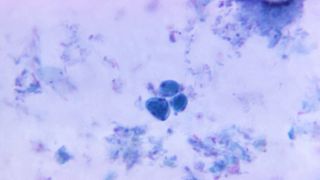
If you experience diarrhea, stomach pain, weight loss, itching around the anus, gas or constipation, it's possible you could be dealing with an infection caused by Blastocystis hominis. You can also carry this single-cell parasite and have no symptoms whatsoever.
Experts aren't sure exactly how people get it — poor sanitation, eating or drinking contaminated food or water, exposure to animals or being in daycare have been flagged as risk factors for infection. It's pretty common for people to carry the parasite in their intestines, and if they develop symptoms, they can be treated with medication. That said, you'll need to submit a stool sample to get an accurate diagnosis. The good news is that the illness will often go away on its own.
Crabs (pubic lice)

You may think of crabs as a sexually transmitted infection, because they most often pass from person to person during sex. But pubic lice don't cause infections — they're parasitic insects that feed on human blood and are typically found in the genital region, though they can pop up on other coarse hairs on your body.
Pubic lice are more common in adults, as they spread largely through sexual contact. Sometimes the bugs are visible to the naked eye, though their main symptom is itching in the genital area. Treating them is fairly simple and effective, involving special shampoos and creams. After treatment, make sure to wash any bedding, clothing or towels in hot water.
Crypto
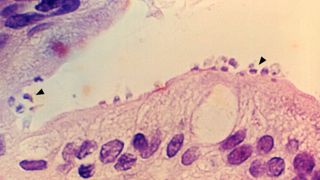
Cryptosporidium is the parasite behind the diarrheal disease cryptosporidiosis, also called "Crypto." This parasite has an outer shell that protects it from chlorine disinfection and lets it survive for long periods of time. It can spread to people in a variety of ways, but drinking contaminated water is the most common. In fact, the parasite is the top cause of waterborne disease in people in the U.S.
Immunocompromised people can be more vulnerable to the parasite and have more severe symptoms, including stomach cramps, watery diarrhea, fever, nausea and vomiting, which can last several weeks. Doctors diagnose Crypto with a stool sample and typically don't have to treat it, although medication is available if needed.
Dientamoeba fragilis
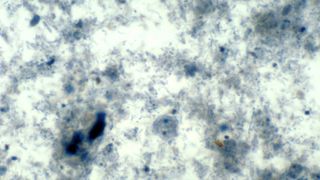
Dientamoeba fragilis is a parasite that infects the large intestine in humans, but it can't spread to other parts of your body. It's common around the world. Scientists aren't sure how people get D. fragilis, but suspect people typically accidentally swallow it. Some experts think that the eggs of a different parasite, called a pinworm, may help protect D. fragilis and enable it to spread.
Symptoms include diarrhea, abdominal pain, weight loss, nausea, fatigue and not feeling hungry, although not everyone develops symptoms. Doctors diagnose the infection with stool samples, and may request multiple samples over a few days. Medicines can treat it.
Diphyllobothriasis

The tapeworm Diphyllobothrium latum is the largest of its kind that can infect humans. The parasite can grow up to 30 feet (9 meters) long, and can lead to intestinal obstruction and gallbladder disease. Most people don't have any symptoms, so doctors have to take a stool sample to look for eggs from or parts of the tapeworm. If you do have symptoms, they can include stomach discomfort, diarrhea, vomiting and weight loss. You can get the tapeworm by eating undercooked or raw fish; freezing or cooking the fish will kill the parasite. Luckily, medications can treat this parasite.
Lymphatic filariasis
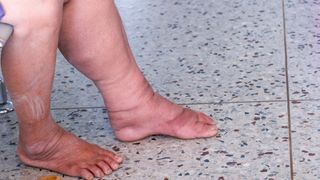
This parasitic disease is caused by worms that live in the human lymphatic system, part of the immune system that helps rid the body of wastes and pathogens. It's spread via the bites of several mosquito species. It can cause lymphedema, or swelling, and notably, swelling of the scrotum, called elephantiasis.
The parasite is most common in people in subtropical and tropical areas. Doctors diagnose it with a blood test. An annual dose of medicine can help treat the infection and prevent it from spreading in communities; however, it doesn't kill all the adult worms but does kill their smaller offspring. Even if the parasite is gone, you may still have effects from it.
Giardiasis
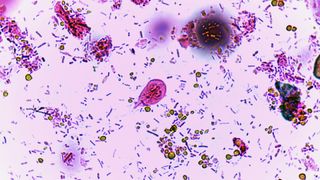
Giardia is a tiny parasite that causes the diarrheal disease giardiasis. You can acquire it from surfaces, soil, food or water that's contaminated with the feces of infected people or animals. The infection is found worldwide. Some people have no symptoms while others have diarrhea, gas, greasy stools, stomach cramps, vomiting and dehydration within one to two weeks of infection. These symptoms can be the same in pets and humans. There's a low risk of getting this parasite from your dog or cat, though, because the type of Giardia that infects these pets is different from the type that infects humans.
Head lice
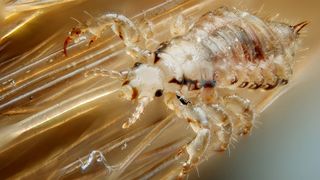
Pediculosis, commonly called head lice, is an infestation that spreads most often when people come in contact with an affected person's hair. Spread via clothing or hair brushes is uncommon. The culprit is Pediculus humanus capitis, a parasitic insect, which pets like dogs and cats can't transmit. Symptoms include tickling and itching on your scalp, and if you scratch a lot, you can develop sores. Once you're alerted that you have head lice — your doctor can probably see them with a magnifying glass — there are prescription and over-the-counter medications to kill the insects.
Hookworm
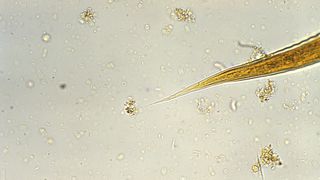
Hookworm is pretty common around the globe, but it's no longer as widespread in the U.S. The most common types of hookworm are Ancylostoma duodenale and Necator americanus. Hookworm eggs pass through human feces:if a person goes to the bathroom outdoors, the eggs can get into the soil, and the larvae can get into broken skin if you come in contact with the soil. In fact, it most commonly infects people when they walk on contaminated soil, and poor hygiene plays a factor in transmission. Some people have gastrointestinal symptoms, but many have none. You can develop anemia due to blood loss, so getting diagnosed is key; doctors collect a stool sample to confirm if you have hookworm. Medication is available to treat the parasitic worms.
Intestinal roundworms

Roundworms are a leading cause of parasitic diseases across the world, although the infections are not common in the U.S. One type of roundworm is Ascaris lumbricoides, which is often called just Ascaris and causes an infection called ascariasis. The worms' eggs pass through feces. If someone goes to the bathroom outdoors and another person's broken skin comes into contact with the contaminated dirt or they eat contaminated produce, it can spread to others. There often are not any symptoms, though they can include upset stomach or pain. Severe infections can lead to intestinal blockages or, in children, slow a kid's growth due to malnutrition. Physicians diagnose it by examining a stool sample. Medication is available to treat it.
Malaria
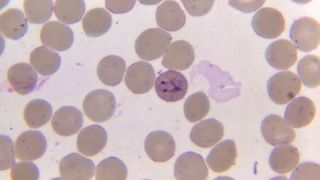
Also called Plasmodium infection, malaria is a disease that's caused by a parasite. Anopheles mosquitoes spread malaria from one person to another, as a mosquito can pick up the parasite if they bite a person infected with it. Symptoms of malaria include flu-like symptoms, such as fever and chills. If it's not treated, the disease can cause complications. In 2022, 249 million people across the world had malaria. Some cases are diagnosed in the U.S. each year but typically occur in people who have recently traveled to places where the disease regularly spreads.
Scabies
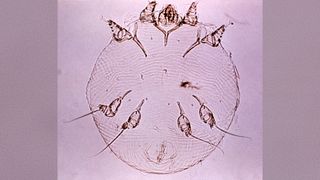
A mite known as Sarcoptes scabiei causes scabies. The condition occurs when the mite digs itself into the skin. That's where it lives and lays eggs. A pimple-like rash and itching are the main symptoms of the infestation, which is spread by close contact with a person who has scabies. The rash may be limited to areas like the wrist, armpit, finger webbing, genitals, waist or buttocks. You'll find scabies throughout the world, especially in crowded living spaces, such as nursing homes and prisons. The mites can live for one to two months in people's skin, which makes them hard to get rid of. Scabies can typically be diagnosed visually, and luckily, medicines called scabicides can eliminate the parasite.
Whipworm
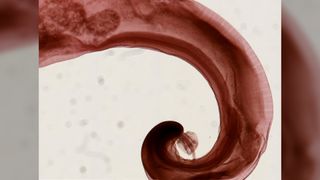
This parasitic worm causes trichuriasis, a disease that's pretty common throughout the world, especially in warm climates with inadequate sanitation. Its eggs pass through the feces of an infected person, and it spreads to others who come into contact with contaminated soil, either by walking on it or by eating produce with the parasite on it. Some people have no symptoms; severe symptoms include painful bowel movements and rectal prolapse. A doctor can diagnose it by examining a stool sample. Medications can treat the condition.
Clonorchis
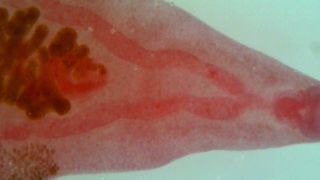
People who eat raw or undercooked fish in areas where this parasite is found — namely in Asia — can get infected with the Clonorchis parasite. The organism is known as a "liver fluke" parasite because it infects the liver, as well as the gallbladder and bile ducts. Freshwater snails eat Clonorchis eggs and release larvae that then enter freshwater fish. Most people with the parasite don't have symptoms, but when they do emerge, they can include indigestion, stomach pain, diarrhea and constipation. The infection can last for 25 to 30 years, which is how long the parasites can live in the body. Your doctor will check your stool to see if eggs are in there. The good news is there's medication that can treat it.
Pinworm

Enterobius vermicularis is a roundworm that causes what's known as pinworm infection, which is also called enterobiasis or oxyuriasis. The infection can affect anyone but it's most common in children, and those who live in close quarters. It's spread when pinworm eggs are transmitted when contaminated feces comes in contact with someone's mouth, such as via contaminated bedding, food or clothing. Sometimes the worm's eggs can spread from underneath fingernails into the mouth, if their hands come in contact with feces. Symptoms include itching around the anus. To diagnose the infection, doctors look for worms near the anus or stick tape around the anus to see if worms are there. Over-the-counter medications can treat the infection.
Keratitis
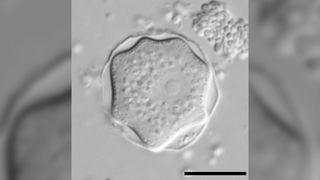
This parasitic infection is caused by the single-celled organism Acanthamoeba, a type of amoeba. It's found globally in water and soil, and it can cause infections of the eyes, skin and central nervous system, which includes the brain and spinal cord. It can enter the body through wounds or through the nostrils, and infections have also been tied to swimming with contact lenses. Blurred vision, sensitivity to light, eye pain and tearing are all symptoms of the eye infection, specifically. Eye scraping, brain scans, biopsies or spinal taps can be used to diagnose the illness. Eye infections can be tough to treat. Skin infections can be treated when they haven't spread to the central nervous system, but if the parasite gets into your brain, it can be fatal.
Toxocariasis
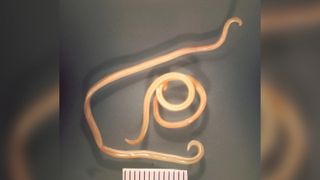
This roundworm infection is caused by the larvae from two species of Toxocara roundworms, called Toxocara canis, which people get from dogs, and Toxocara cati, which is from cats. It can't spread between people. Experts think a lot of humans have been exposed to the parasite because about 5% of American adults carry antibodies to it. Pets that have the parasite shed it in their feces, which can be passed to people if they don't adequately wash their hands or if they eat food contaminated with traces of dirt that contains the eggs. In rare cases, it can be passed from eating undercooked meat that contains that larvae. It can affect the eye and other organs of the body, such as the liver and lungs. However, some people with the parasite have no symptoms at all. Medications can treat the systemic infection, if it occurs, while the type that affects the eyes is harder to treat.
Schistosomiasis
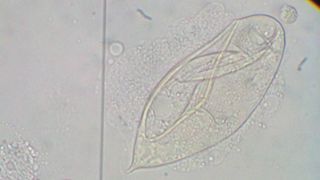
Also known as bilharzia, schistosomiasis is a disease caused by parasitic worms including Schistosoma haematobium, S. japonicum and S. mansoni. People from across the globe can be affected, though the worms haven't been found in the U.S. The parasitic worms live in some types of freshwater snails. Cercariae, the larval form of the parasite, is the most infectious form and it can get from the snail into the water. People can then get schistosomiasis if they are exposed to contaminated water. A few days after exposure, you may have itching or a rash that can lead to chills, fever, cough or muscle aches within a month or two. Urine or stool samples, or a blood test, can help you get an accurate diagnosis. Medications are available to treat the parasitic infection.
Cyclosporiasis
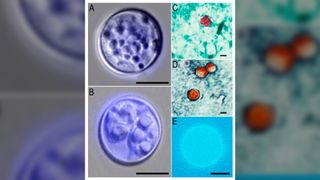
Cyclosporiasis is an illness that affects the intestines, and it's caused by the parasite Cyclospora cayetanensis. People can get the parasite if they eat contaminated food or drink contaminated water. It's often in tropical and subtropical areas of the world. Outbreaks from food in the U.S. have been tied to imported produce. Symptoms can include loss of appetite, watery diarrhea, weight loss, stomach cramps or pain, bloating, gas, fatigue, nausea and explosive bowel movements. A stool sample is needed for diagnosis. Antibiotics can treat the infection, even though the disease isn't caused by bacteria.
Cysticercosis
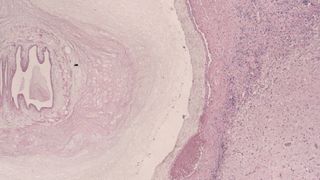
The larval cysts of the tapeworm Taenia solium can cause a parasitic tissue infection known as cysticercosis. People get it when they accidentally swallow eggs in the feces of a person who has the tapeworm, which can happen if your hands aren't adequately cleaned before eating, for instance. Pigs can also get the infection if they eat tapeworm eggs. A person can't get cysticercosis from eating undercooked pork, but they could instead end up with an adult worm living in their intestines, which is known as taeniasis. Both cysticercosis and taeniasis occur globally but are most common in Africa, Asia and Latin America. Blood tests can diagnose infections, and brain scans can be used to diagnose it if it spreads to the brain. Some people don't require treatment, but medications are available for others.
Toxoplasmosis

Toxoplasmosis is a foodborne illness that's considered a leading cause of death from foodborne illnesses in the U.S. However, that said, more than 40 million people in the country carry the parasite behind the infection, called Toxoplasma gondii, which only rarely causes severe infection. Only a small percentage of people carrying the parasite have symptoms because the immune system normally overpowers it. Infection can be especially serious in people who get it before or during pregnancy and in those who are immunocompromised. Pregnant people are advised to avoid changing cat litter during their pregnancy, because the parasite is known to shed in cat feces. Some people who fall ill from the infection will feel like they have the flu or experience swollen lymph glands or muscle aches lasting for a month or more. Serious cases can impact the brain, eyes and other organs. Doctors use blood tests to diagnose it; some people don't need treatment but medications are available.
Trichomoniasis
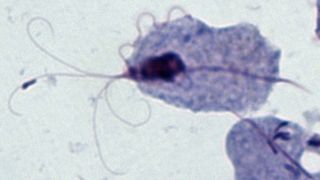
Trichomonas vaginalis is the parasite that causes trichomoniasis, a common sexually transmitted infection that's also called "trich". Only about 30% of people develop symptoms, which include burning and itching, pain when urinating and genital discharge. Condoms can reduce the risk of spreading it. Your doctor can collect a urine or discharge sample to confirm a diagnosis. Antibiotics can easily treat the infection; not treating it will increase your risk of spreading it.
Babesiosis
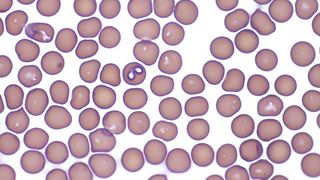
Babesia microti parasites cause a disease called babesiosis and get into people when they're bitten by blacklegged ticks or deer ticks. In the U.S., where the disease is fairly rare, transmission occurs mostly in the Northeast and upper Midwest, and it gets more common during the warmer months. Flu-like symptoms can accompany infection but you may not have symptoms at all. Doctors diagnose it with blood tests and there are treatments available.
Echinococcosis
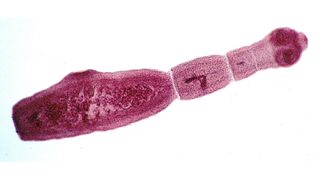
This parasitic disease is caused when a tapeworm in the genus Echinococcosis infects a human. It's either classified as cystic echinococcosis (CE) or alveolar echinococcosis (AE). The Echinococcus granulosus tapeworm that commonly causes CE is found in dogs, sheep, goats and pigs. Most people don't have symptoms when infected, but the infestation can lead to enlarged cysts in the liver, lungs and other organs. Foxes, dogs and coyotes carry Echinococcus multilocularis, which causes AE. It's rare in humans but is more serious than CE, causing parasitic tumors and sometimes fatalities.
Leishmaniasis
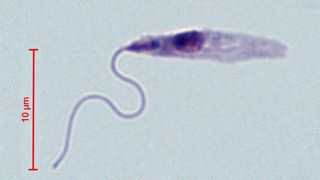
You'll find the Leishmania parasite in the tropics and subtropics, as well as southern parts of Europe. It causes leishmaniasis, which happens when you're bitten by a sand fly that carries the parasite. There are many different types of leishmaniasis that can affect humans; some cause skin sores while others affect organs like the liver and spleen. Your doctor may use a variety of tests to diagnose it; they may look at skin samples, bone marrow samples or blood tests. Sometimes skin sores heal on their own while sores can also occur in the nose, mouth or throat. Other times, it can be fatal.
Naegleria fowleri
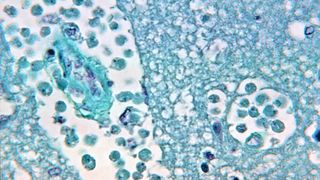
Naegleria fowleri is often referred to as a "brain-eating" amoeba. It lives in soil and warm fresh water like lakes, rivers and hot springs. If water containing the parasite goes up your nose, it can get into your brain and cause an infection called primary amebic meningoencephalitis. It's super-rare — only about three people in the U.S. get it each year, on average. But the infections are almost always fatal. Symptoms are similar to having bacterial meningitis — think fever, headache, stiff neck, vomiting or confusion — which makes it harder to get a quick diagnosis.
Paragonimus
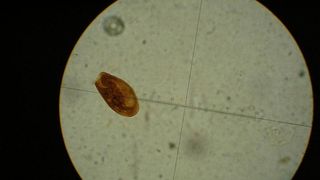
The Paragonimus lung fluke, or flatworm, can infect people's lungs if they eat raw or undercooked crab or crayfish. It's uncommon for the flatworm to travel to the central nervous system, but it sometimes can. Infection with this parasite is rare in the United States but has been reported in the Midwest. The infection is usually diagnosed by checking saliva or stool samples, though tissue biopsies aren't out of the question. Effective medications are available to treat the parasitic infection.
Anisakiasis
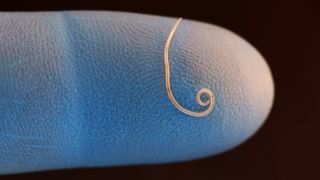
Parasitic worms are to blame for anisakiasis, which is also called herring worm disease. It can be caused by species of roundworms known as herringworm, codworm or sealworm. The larvae get into the water when infected marine mammals defecate, and crustaceans then eat the larvae and fish or squid eat the crustaceans. Humans can then get the parasite by eating raw or undercooked seafood. The Pseudoterranova worms invade the stomach wall and intestines in humans. Symptoms can include mild fever, nausea, stomach pain, vomiting, abdominal distention, diarrhea, and blood and mucus in the stool. Some people have allergic reactions that can, in rare cases, lead to anaphylaxis. Your doctor may use endoscopy or surgery to treat the infection by removing the worm.
Sarcocystosis

This disease is a result of the parasite Sarcocystis. It causes two types of disease in humans: the intestinal type, which causes mild fever, vomiting and diarrhea, and the muscular type, which includes muscle pain and joint pain and swelling, as well as fever. Sarcocystosis is found in tropical or subtropical countries. Eating undercooked meat containing the parasite causes the intestinal form, mostly commonly, and people who get the muscular type do so after consuming the parasite in water or food that's been contaminated with animal feces. Doctors take stool tests to diagnose the first type and tissue samples to see if you have the second form. There's no proven treatment to get rid of it, but anti-inflammatory medicines can help.
Trypanosomiasis
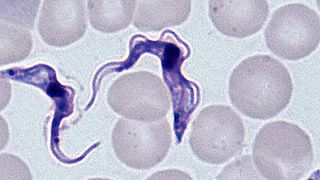
Also known as sleeping sickness, human African trypanosomiasis (HAT), is caused by the parasites Trypanosoma brucei gambiense and Trypanosoma brucei rhodesiense. Tsetse flies spread the disease to people. It's similar to American trypanosomiasis, or Chagas disease, in the Americas, in that they're caused by the same type of organism. HAT causes fever, headache, enlarged lymph nodes, joint pain and itching.
The parasites can get into the central nervous system and lead to confusion, coordination problems, sleep disturbances and behavior changes. Blood and spinal fluid tests are used to diagnose the disease, and medications are available depending on the stage of the disease. In untreated cases, it almost always causes death.
Sign up for the Live Science daily newsletter now
Get the world’s most fascinating discoveries delivered straight to your inbox.

Kristen Fischer is a writer living at the Jersey Shore. Her work as been published at WebMD, Healthline, Health, Prevention, and more. Visit www.kristenfischer.com to learn more.